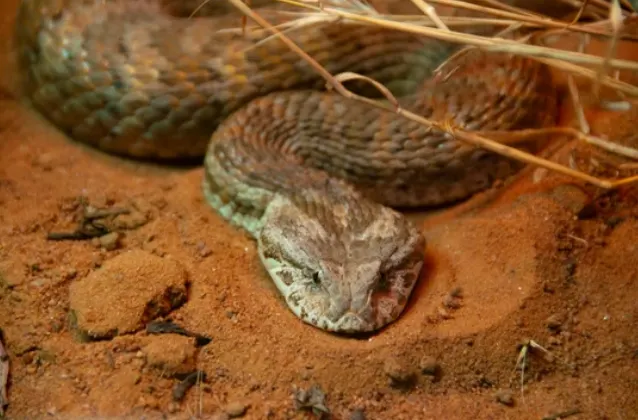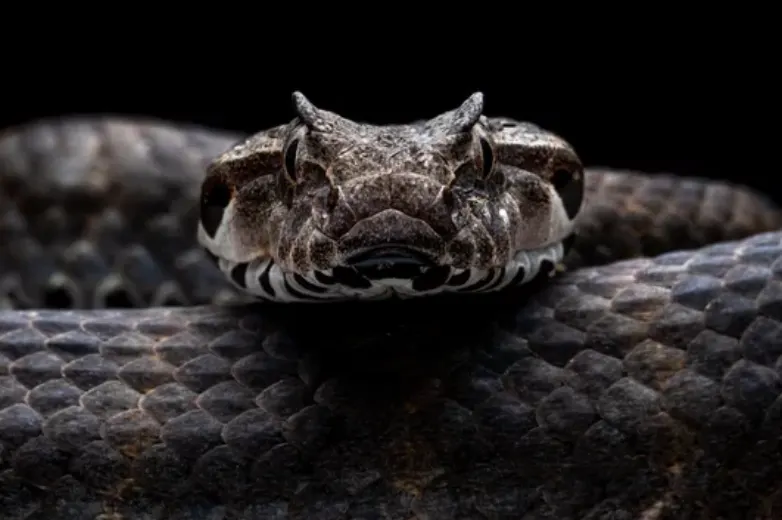The Death Adder (Acanthophis antarcticus) is a venomous snake native to Australia and Papua New Guinea. Despite its fearsome name, this elusive reptile plays a fascinating role in its ecosystem. Known for its camouflage, rapid strikes, and deadly venom, the Death Adder stands out among Australia’s diverse snake population.

Let’s dive into the intriguing world of this snake and discover what makes it one of nature’s most remarkable hunters.
1. The Death Adder’s Appearance: A Master of Camouflage
One of the first things you’ll notice about the Death Adder is its viper-like appearance, but here’s a surprise: it’s more closely related to cobras than vipers. Its distinct features include:
- A triangular head, similar to vipers.
- A stocky body that gives it a robust appearance.
- A thin tail with a short spine, often used as a lure for prey.
Its color pattern is the key to its stealth. The Death Adder’s body is covered in bands of black, brown, and red, making it blend seamlessly into its surroundings, whether that’s a woodland floor or a grassy field.
2. Habitat and Distribution: Where Do Death Adders Live?
Death Adders are found across Australia, from forests to grasslands, but they avoid desert regions. Here’s a closer look at their preferred habitats:
- Heathlands and woodlands are prime spots where they thrive.
- They are also found in coastal areas, but rarely in urban settings.
- The only major city where Death Adders have been reported is Sydney.
Since these snakes are masters of camouflage, it’s easy for humans to encounter them without realizing it, especially when hiking or exploring the wild.
3. Hunting Strategy: The Art of Ambush
What makes the Death Adder stand out as a predator is its ambush hunting strategy. Unlike many other snakes that actively pursue prey, the Death Adder remains still, patiently waiting for its prey to come within striking range.
Here’s how it works:
- The snake uses its tail as a lure, wriggling it to mimic a worm or insect.
- When unsuspecting prey, such as a small bird or mammal, comes close, the Death Adder strikes with lightning speed.
- Its fangs deliver a lethal dose of neurotoxic venom, which quickly immobilizes its target.
Incredibly, the Death Adder can strike and return to its ambush position in less than 0.15 seconds, making it one of the fastest striking snakes in the world.
4. Venom: How Dangerous Is the Death Adder?
The Death Adder’s venom is extremely potent. It contains neurotoxins that disrupt the nervous system, causing paralysis and, if left untreated, can lead to death. Before antivenom was developed, the mortality rate from a bite was high.
Today, the situation has improved:
- Antivenom is readily available, significantly reducing the number of fatalities.
- However, if bitten, it’s essential to seek medical attention immediately. Delays in treatment can still be fatal.
Despite its deadly venom, the Death Adder is not aggressive toward humans and will generally avoid confrontation unless provoked or stepped on.
5. Reproduction: Giving Birth to Live Young
One unique aspect of the Death Adder’s life cycle is that it gives birth to live young rather than laying eggs. This characteristic is rare among snakes and gives the newborns a better chance of survival.
- Females can give birth to anywhere from 3 to 30 offspring.
- The young are completely independent from birth and must fend for themselves from the moment they’re born.
Death Adders reach sexual maturity at around 2 years old and can live up to 15 years in the wild, although many face threats from predators and environmental challenges.
6. Threats and Predators: The Challenges Death Adders Face
While the Death Adder is a formidable predator, it is not without its own challenges. In the wild, the snake faces threats from both natural predators and human activities:
- Cane toads, an invasive species in Australia, are particularly dangerous to Death Adders. Although the snake sometimes eats these toads, their toxins can be fatal.
- Buzzards and crows are known to prey on both young and adult Death Adders.
Despite these challenges, the Death Adder’s population remains stable, and the species is listed as Least Concern on the IUCN Red List.
7. Misconceptions and Myths: What’s in a Name?
The name “Death Adder” contributes to its intimidating reputation, but many myths surround this snake.
Common misconceptions:
- It’s not a true adder: Despite the name, the Death Adder is not a member of the viper family like European adders.
- Not overly aggressive: Death Adders don’t seek out humans or other animals to bite. Most bites occur when the snake is accidentally stepped on.
Its name likely comes from its viper-like appearance and the fact that its venom was once highly lethal before the advent of antivenom.

8. Conservation: Stable But Cautious
The Death Adder population is currently stable, and the species is not considered at risk. However, conservationists keep an eye on several factors that could impact its survival:
- Habitat destruction due to urbanization and agriculture could threaten localized populations.
- The spread of invasive species, like the cane toad, remains a persistent danger.
Conservation efforts focus on preserving the snake’s natural habitats and mitigating the effects of invasive species.
The Death Adder’s Place in Nature
The Death Adder is a remarkable snake that combines stealth, speed, and deadly venom to thrive in the wild. Its unique adaptations, such as its ambush hunting strategy and camouflaging abilities, make it one of the most effective predators in its environment.
For humans, understanding and respecting this snake is key. While it can be dangerous, it poses little threat if left undisturbed. The Death Adder plays an essential role in controlling small mammal populations and maintaining the balance of its ecosystem.
- Enchi Ball Python: A Unique and Stunning Morph of Python regius - March 27, 2025
- Emerald Tree Monitor: The Enigmatic Green Guardian of the Rainforest - March 26, 2025
- The Egyptian Cobra (Naja haje): A Fascinating Serpent - March 25, 2025
